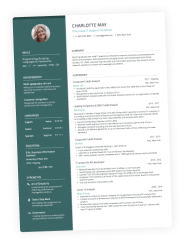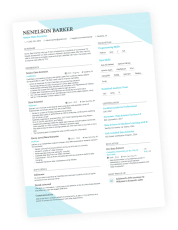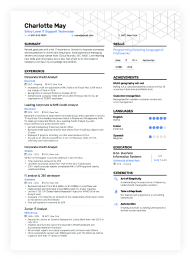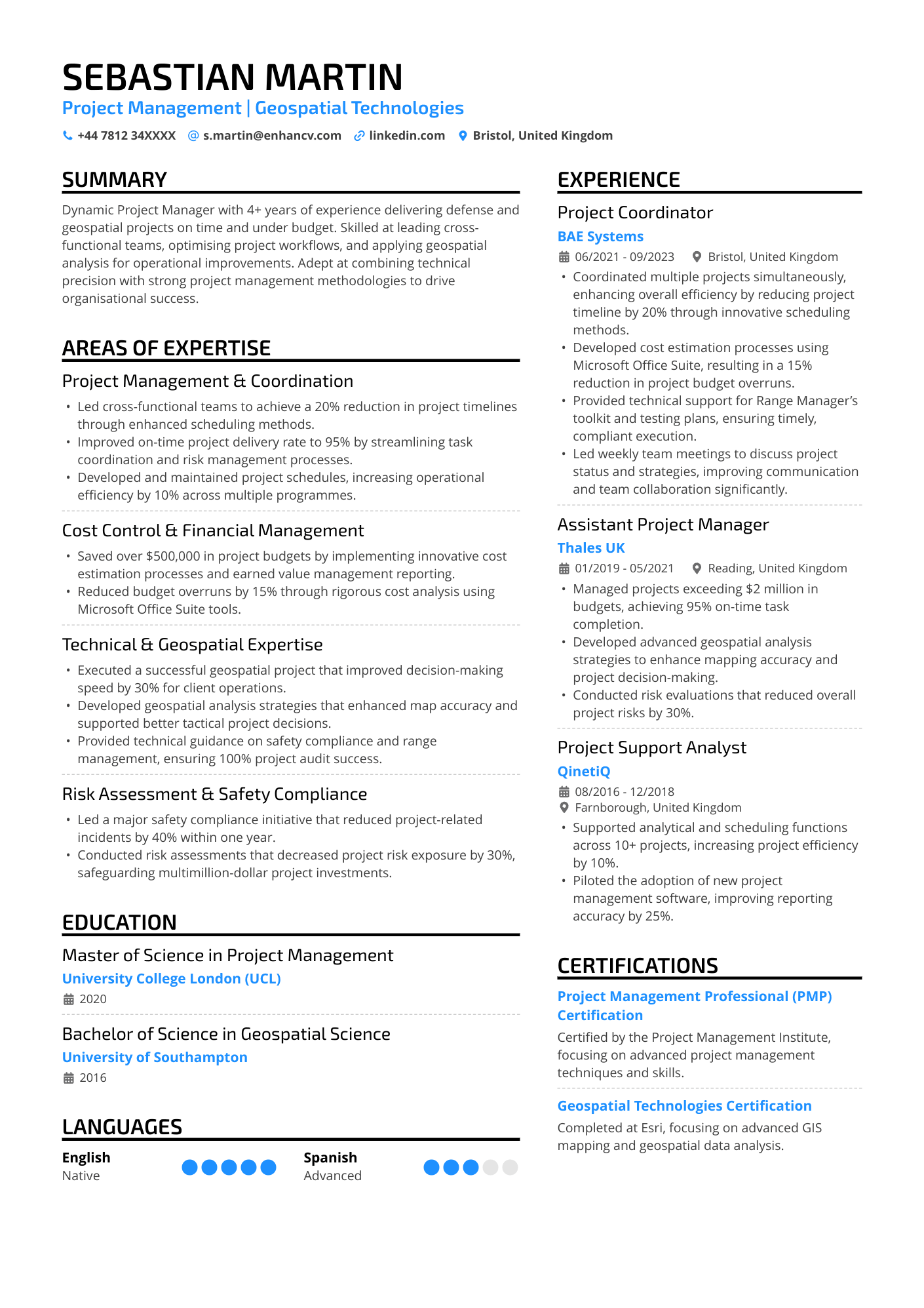CV header or CV heading: what’s the difference? Not much really, but “CV header” is the term that actually fits. It’s what most recruiters say, it’s what shows up in CV tools like Enhancv, and it’s the clearest description. And, if you searched for “CV heading,” don’t worry, you’ve still landed in the right place.
Either way, we’re talking about the top part of your CV. This space sets the tone of your whole application. Before anyone sees your experience or skills, they’ll see your name, your contact details, and your portfolio or LinkedIn link if you’ve chosen to put it up there.
You already know the deal: First impressions matter. Luckily, we’ve got everything you need to make the right one.
In this guide, we’ll walk through what to include in your CV header, what to skip, and how to keep this section looking clear and easy to read. Let’s get started.

Key takeaways
- Your CV header is the first thing a recruiter sees, so it needs to pull its weight.
- Keep it simple: name, job title, contact details, and one or two helpful links.
- Use a clean layout with consistent formatting across your whole CV.
- Don’t cram in extras like your full address, date of birth, or a photo.
- A short tagline can add impact, but only if it’s relevant and well written.
- If it’s easy to read and easy to use, you’re on the right track.
Looking for a way to get the recruiter’s attention fast? Make sure your CV hits the mark. Use our CV uploader tool to check it now:
Is your CV good enough?
Drop your CV here or choose a file. PDF & DOCX only. Max 2MB file size.
Let’s kick things off with what a CV header is and why you need to perfect this part of your next application.
What is a CV header? (and why it matters)
The CV header is the bit right at the top that tells people who you are and how to reach you. While it might seem like a formality, it's the first thing most people see.
If it’s sloppy or hard to read, it sets the wrong tone for your whole application. Mess it up, and the recruiter may not bother to carry on reading.

PRO TIP
Readers tend to remember the first thing they see. This is a phenomenon known as the primacy effect. And, you can use it to your advantage.
By creating an impressive CV header, you can set the tone for how they judge the rest of your application. Get this aspect of the document right, and you can make a lasting impression.
Your header includes your basic details. Usually, you’ll want to add your full name, the type of role you’re after, your phone number, an email address, and where you’re based. You should also make sure that your CV header is clear and easy for the recruiter to read.

Why your CV header matters
- First impressions count: The CV header is the first thing employers or recruiters see, and your first chance to make the right impression.
- It makes the recruiter's job easy: A clear header makes it easy for them to contact you, which is the whole point of applying.
- Create the right vibe: It helps your CV look polished and professional right from the off. This shows attention to detail, which recruiters will always notice.
- It makes your CV look modern: Including the right info (and leaving out overly personal details) stops your CV from looking dated or too busy.
- Optimise for ATS: Your CV header can help with applicant tracking systems (ATS), if your job title matches the vacancy, for example.
- It can be eye-catching: It makes your CV easier to spot in a pile, especially if you’re applying for jobs in print or handing it over in person.
Now you’ve got to grips with why a CV header matters, let’s deal with the elephant in the room.
CV heading vs. CV header: What’s the difference?
If you’ve seen both terms floating around and wondered if they’re the same thing, you’re not alone. It’s easy to get them mixed up, and plenty of people do.
The truth is that CV header and CV heading are often swapped in and out like they mean the same thing. But if we’re being picky (and for the sake of clarity here, we are), there is a teeny difference.
Your CV header is the bit right at the top with your name, contact details and job title.
A heading, on the other hand, could be one of two things; either the same as a header or any label used to mark out a section, such as your Work Experience or Skills. Confusing, right?
So while people use both terms, CV header is the more accurate and it’s what we’ll stick with here.
How to write a clear CV header
Now that we’ve dealt with the red tape, let’s talk about how you can craft a clear CV header.
The first thing you need to think about is what you should write in this section:

What to include in your CV header
- Your full name: Make sure your name’s right at the top and easy to spot. Avoid nicknames, unless you use them professionally.
- Job title: This can sit just under your name. If you’re already in the industry, use your current title. If you’re changing careers or are fresh out of uni, put the type of role you’re going for instead. Keep it short and relevant.
- Email address: Your email address should be professional. If in doubt, use one with your first and last name in it. Avoid old accounts with silly URLs and definitely don’t include any joke names. The small details do matter.
- Phone number: This can be your mobile number. Using landlines has become outdated. Make sure it’s correct—if they can’t reach you, the rest doesn’t matter.
- Location: Only include your city or town, and county. You don’t need to put your full address anymore.
- Hyperlinks: You can also include a hyperlink to your portfolio or LinkedIn page. Only add them if they’re up to date. For example, if your LinkedIn’s just a list of GCSEs and a blurry photo from 2014, it’s best to leave it.
There’s also no need to write “CV” in your header, and definitely don’t label it “Curriculum Vitae.” This is old-fashioned and could make it seem like you’re unfamiliar with modern hiring practices.
Ready to put that advice into practice? Remember that your CV needs to tick the above boxes while also being simple to follow. If it does that, you’ve already won half the battle.
Here’s an example of a well-written CV header:
You’re only human, and it’s easy to make mistakes when you’re working on your CV header. One of the biggest pitfalls you’ll want to avoid is including unnecessary information.
Let’s take a look at the things you should leave out:

What NOT to put in your CV header
- Your full address:Employers just need an idea of where you’re based, not directions to your front door.
- Date of birth, age, or anything too personal: Not only is this info irrelevant, it can lead to unconscious bias. The same goes for your marital status, gender, nationality or anything else that’s got nothing to do with your ability to do the job.
- National Insurance number. While it may feel natural to include this on applications, it’s not something recruiters need. If you’re offered the role, you’ll have to give this info to the HR manager. Until then, keep it to yourself.
- Photos: Unless you're applying for a modelling or acting job, there’s no need to include a headshot.
- Multiple phone numbers or email addresses: One of each is plenty. Keep things simple and make sure the ones you do add are 100% correct.
- Outdated or irrelevant links: You’re better off with no links than a bad one. If your portfolio or LinkedIn is out of date, don’t link to it.
- Extra clutter: Your header isn’t the place for quotes, logos, or any other decorative bits. These can interfere with ATS systems.
Cramming your CV header full of these extras can make you look unprofessional and, ultimately, harm your chances of landing an interview.
Here’s how a bad header might look:
By this point, you should have your CV header content down. But looks matter, too. Making sure you’ve nailed the style of the CV header could make a huge difference.
What a good CV header looks like
Looks matter as much as content. When you send a CV to a company, the first thing they’ll notice is the design you’ve used. If it looks overly-complicated or hard to read, you may find that you fall at the first hurdle. Keep that in mind when you’re creating your CV header.

Remember to customise your header!
CV headers should never be one-size-fits-all. When you’re applying for different roles, it’s important to tailor your CV—including your header.
Make sure your details fit what the recruiter asks for and match the job title to the vacancy. These small tweaks can help you get past the ATS and speed things up.
Creating a CV header that makes an impact doesn’t have to be hard, and you don’t have to be a design whiz, either. Just emphasise what matters the most.
What makes a good CV header?
Knowing how to craft a good-looking CV that gets the recruiter’s attention is a must. But if it’s been a while since you gave it a whirl, you might not know where to start.

Why the header design matters
When people read a document, their eyes follow either an F-pattern or a Z-pattern. That means that they naturally linger at the top of the page longer than anywhere else.
Chances are, they’ll remember the header and this may even impact whether they carry on reading (or not!). So, taking the time to create an attractive and readable header is a must.
Let’s take a look at some ground rules:
Opt for a clean design and build trust
Recruiters are always looking for real attention to detail, and they’ll judge you based on your CV. Get the first impression right by opting for a clean design that builds real trust. Remember to prioritise clarity over all. That means ensuring the content of your CV can be read easily.
Make the details skimmable
Is your CV header skimmable? Recruiters don’t have long to spend reviewing each new CV. It’s your job to make sure they can get the information they need quickly and easily. Using clear spacing, line breaks, and a logical order helps make this part of your CV easy to scan.
Add a tagline under your name (optional)
Want to give your CV header that extra razzle-dazzle? Consider using a tagline along with your job title. You simply need to list this below your name and job as an extra one-liner.
Use this as a chance to add real value to your application. You can add in some power verbs, for example, or include details of your seniority level.
CV header with a tagline
Priya Patel
Senior Content Strategist
Driving audience growth through bold ideas, smart SEO, and results-led storytelling
priya.patel@email.com
07700 1234xx
London, UK
linkedin.com/in/yourname
Choose a simple and stylish colour scheme
You’re not trying to win any design awards here. It’s not about going overboard with colour or flashy designs. If your CV header looks too busy, the recruiter may struggle to get the information they need.
If you’re not sure where to start, keep things simple. Sticking to a basic, yet attractive design is a surefire way to make sure that your CV gets noticed for all the right reasons.
Blues and greens tend to work well when you’re choosing colour combinations. These are professional colours that don’t look too garish, and look great against a white background.
Here’s an example of a professional CV created with Enhancv’s AI CV Builder:
How to format your CV header: UK standards
If you’ve previously applied for roles abroad, you might not be familiar with UK header standards. It’s time to change that. Getting to know the rules and using them will show British recruiters that you’ve got your finger on the pulse.
Let’s break down the main formatting rules you need to follow:

CV header formatting rules
- Get the structure right: Follow a standard structure. Your full name, job title (or tagline), email address, phone number, location, and any links.
- Make your name a big deal: Your name should be the largest thing in the CV header. Make it between 14 and 16pt. The rest of the content can be between 10 and 12pt.
- Include line breaks: Keep each bit of info on its own line. You only need to think about this when creating a Word CV—templates do it for you.
- Use left-aligned or centred: It doesn't matter whether you go for left-aligned or a centre structure. But definitely avoid scattered layouts, boxes or icons.
- Skip the columns: They might look neat to you, but they have the potential to trip up applicant tracking systems. Use a one-column structure to side-step this issue.
- Feature white space: Opt for plenty of space around each section. Margins should typically be between 0.5 and 1 inch (1.3-2.5 cm). This makes it easier to read.
It might feel like a lot of information to take in, but don’t panic. The aim of the game is to make your header as neat as you can. The above rules simply help you do that!

Make designing your CV a breeze!
Formatting rules can be tricky at the best of times. Why not use Enhancv’s CV Builder to create a header that’s readable by humans and ATS systems.
Don’t leave anything to chance when applying for jobs. Getting the basics down means that you put yourself in the best position and boost your chances of getting noticed.
How to decide if your CV header is good
If you’ve already designed your CV header, you might be wondering if it fits the bill. To help you along the way, we’ve outlined the key questions you’ll need to ask yourself.

Questions to ask about your header
- Is my name easy to find and read?It should be right at the top in a larger font size than the other content. Make sure it’s clear and doesn’t disappear into the background.
- Am I using a job title or target role under my name? This is your chance to give a bit of direction. Whether it’s the job you’ve got or the one you’re going for, pop it under your name so it’s obvious what you do or want to do.
- Does my email look professional?Be honest about this one. If it’s something you came up with as a teenager or includes words like unicorn, lad, or legend, it’s high time to retire it. It should be something you wouldn’t be embarrassed to say out loud.
- Can a recruiter contact me without extra steps?Your phone number and email should be working. If they need to go hunting through your CV to find a way to reach you, they probably won’t make the effort.
Has your CV header passed the test? If you answered “no” to any of the above questions, you’ll want to go back and make some much-needed edits to this part of your application.
CV header examples for inspiration
Of course, the style of CV you choose may also depend on your field and seniority level. If you’re not sure where to begin when it comes to yours, take a look at our CV header examples.
Student CV header example
If you’re a university student creating your CV, don’t feel limited to just writing “Biology Student” or “Business Undergraduate.” Use the space strategically to show where you're headed.
For example, you could write “Computer Science Student and Aspiring Front-End Developer” or “Politics Undergraduate Seeking Policy Internship.” This helps position you for the role you want, not just the course you’re on. It also shows initiative and direction—something employers really value.
Graduate CV header example
Fresh out of university? If you’re new to the career ladder, you can add a tagline to show the recruiter what your goals are. Note: You may also want to expand on this in your CV objective.
Experienced professional CV header example
If you’ve got a good few years of experience under your belt, you might think that speaks for itself. However, you still have to get your header right.
As you can see, all of the above follow a similar structure. Be sure to tweak your header based on both the job you’re applying for and, of course, your level.
Final tips for a standout header
You already know what it takes to craft a great CV header. Before you get to work, we have some final tips for you. Use these to make sure your next application stands out from the crowd.
Check that it’s skimmable
Your CV header should be easy to read and even easier to find. If someone has to squint to work out who you are and how to contact you, you’ve already lost them.
Before you submit your CV, check that your header is doing what it’s supposed to. You can even have a friend take a look and make sure that all the right info is plain and simple.
Make it match the rest of your CV
Your CV is a package deal. There’s no way that your header should look any different from the rest of it. When you’re designing it, use the same font, same alignment, and same structure you do elsewhere.
The general idea is to make sure the whole document looks put together. One of the easiest ways to do that is to use a template. That way, each section of your CV will follow the same style.
Use the same header for your cover letter
It’s not all about your CV. Your cover letter plays a role in whether you impress the recruiter. Using the same header for both your CV and cover letter is a wise move—and a step beyond most candidates.
This presents the two documents as one package, showing you have a high level of attention to detail and that you’re professional.
Use our CV builder to make it easy
If messing around with margins and spacing stresses you out, Enhancv has the solution. Using our CV builder tool means that you don’t have to do the heavy lifting yourself.
We’ve got a wide selection of perfectly designed CV templates to choose from. Why not browse them now and pick the right one for your next application?
Takeaway
Whether you call it a CV heading or CV header, getting this part of your application right is the ideal first step. You don’t have to do anything overly complicated. Instead, keep your eyes on the prize and just ensure your details can be read quickly and easily.




